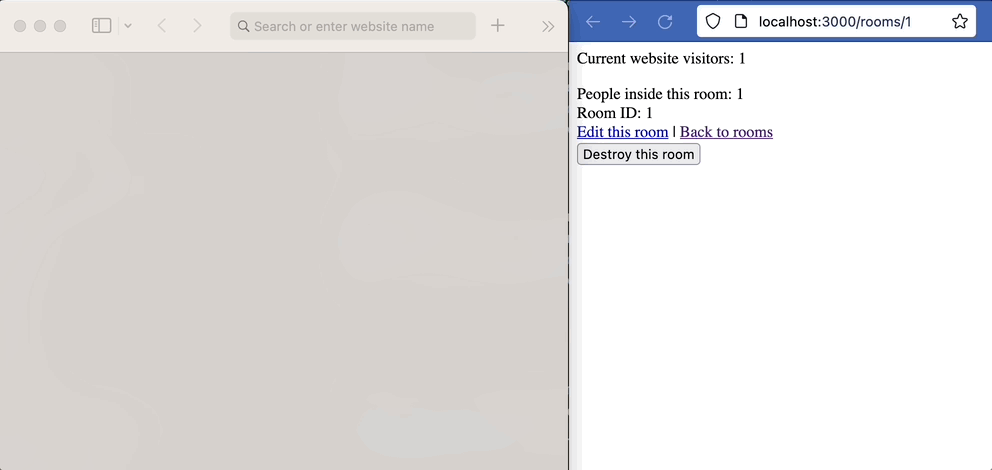 Live Visit Count for website or page. ActionCable, Turbo Broadcasts, Kredis
Live Visit Count for website or page. ActionCable, Turbo Broadcasts, Kredis
It’s amazing that now you can add advanced javascript/websockets features like “Live visitor count” without writing a single extra line of javascript!
A “live visitor count” feature can give users a “you are not alone” feeling. For example, when browsing a Reddit post:

Or when watching a live stream on youtube:

Another example - see other people that have the same google doc open:

“live visitor count” can also boost urgency (booking website example):

By the end of this article you will have created:
- live counter of all visitors on the app
- live conter of all visitors on a specific page or “inside a Room” (like google doc or youtube live video)

Explanation of the above GIF:
- I have 2 browsers open. Each browser = different session.
- When I open the website in the second browser, the visitor count goes from
1to2. - If the user closes the browser tab, visitor count will decrease by
1. - When I open a specific
Roompage, the visitor count goes from1to2for this particular Room. - If a user leaves the Room (closes tab or redirects), visitor count will decrease by
1.
Technologies we will need to implement the “live visitor count”:
- ActionCable - the core technology, that lets us to establish a websockets connection, and see if a user connected or disconnected.
- turbo/streams_channel.rb - a way to link a turbo stream with an ActionCable channel.
-
gem Kredis - a Redis adapter for Rails, where we will store the visitor ids (
session_id).
1. Count all current visitors on your website #
In this example we will not implement user authentication. We will identify separate users by sessions. One browser = one session.
To make session_id available within an ActionCable Channel, you have to add it inside Connection. The Connection has access to request and cookie data.
# app/channels/application_cable/connection.rb
module ApplicationCable
class Connection < ActionCable::Connection::Base
identified_by :session_user
def connect
self.session_user = request.session.id
end
end
end
Next, add a turbo_stream_from broadcast to your application layout.
Importantly, append the channel: VisitorChannel to connect to an ActionCable channel.
Add a placeholder div visitors-counter where we will update the number of current visitors.
# app/views/layouts/application.html.erb
<%= turbo_stream_from :visitors, channel: VisitorChannel %>
Current website visitors:
<span id="visitors-counter"></span>
Create an action cable channel. Don’t use the generator, because you will not need the other extra files and code that rails g channel visitor would give you. It has to inherit from Turbo::StreamsChannel. Add super. That way you will have streams_form automatically imported. You will have access to verified_stream_name_from_params that is :visitors for our current case.
In this case verified_stream_name_from_params = :visitors.
Create a redis unique list and add the session_user on subscribed, remove the user on unsubscribed.
Send a turbo stream broadcast to update this count in everyones views with Turbo::StreamsChannel.broadcast_update_to.
# app/channels/visitor_channel.rb
# class VisitorChannel < ApplicationCable::Channel
class VisitorChannel < Turbo::StreamsChannel
def subscribed
super
visitors_online = Kredis.unique_list "visitors_online"
visitors_online << session_user
update_visitors_count(visitors_online)
end
def unsubscribed
visitors_online = Kredis.unique_list "visitors_online"
visitors_online.remove session_user
update_visitors_count(visitors_online)
end
private
def update_visitors_count(visitors_online)
Turbo::StreamsChannel.broadcast_update_to(
verified_stream_name_from_params,
target: 'visitors-counter',
html: visitors_online.elements.count
)
end
end
Success! Now every visitor of your application will see the visitor count!
Try opening/closing pages in your app from 2 different browsers and see the visitor_count change.
2. Count current visitors on a specific page #
Maybe a more useful feature would be to see the quantity of users on a specific page. For example, we have a scaffold of Room and each room has a #show page.
In this case we will pass an additional room_id param to the turbo_stream_from.
Make the target also unique based on the room_id:
# app/views/rooms/show.html.erb
<%= turbo_stream_from @room, channel: RoomChannel, params: { room_id: @room.id } %>
<%#= turbo_stream_from @room, channel: RoomChannel, data: { room_id: @room.id } %>
People inside this room: <span id="room-<%= params[:room_id]%>-counter"></span>
Now we can access params[:room_id] from our room_channel.rb:
# app/channels/room_channel.rb
class RoomChannel < Turbo::StreamsChannel
def subscribed
super
room_visitors = Kredis.unique_list "room_visitors"
room_visitors << session_user
target = "room-#{params[:room_id]}-counter"
update_visitors_count(room_visitors, target)
end
def unsubscribed
room_visitors = Kredis.unique_list "room_visitors"
room_visitors.remove session_user
target = "room-#{params[:room_id]}-counter"
update_visitors_count(room_visitors, target)
end
private
def update_visitors_count(room_visitors, target)
Turbo::StreamsChannel.broadcast_update_to(
verified_stream_name_from_params,
target:,
html: room_visitors.elements.count
)
end
end
Success! Now when you open a specific room page, it will register a new connection. See the “People inside this room” counter get updated:

That’s it. See you in the next one!
Did you like this article? Did it save you some time?